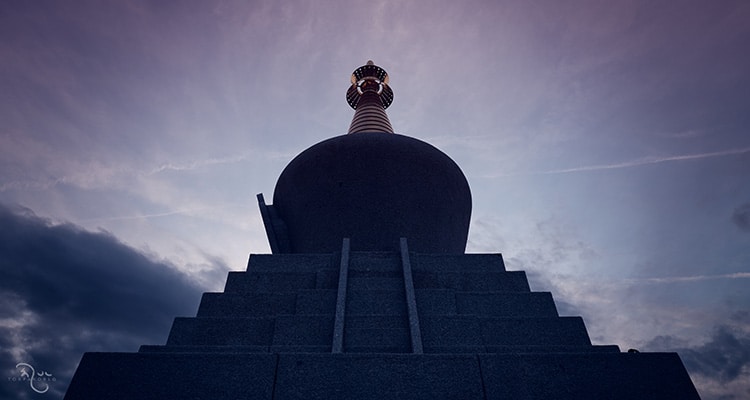The Discovery of Vipashyana Practice
Category: Buddhist Meditation | Buddhist Path | Recent Meditation Posts

The Buddhist meditation practice that takes you deeper
We begin meditating by developing the ability to keep our mind in the present. In this basic form of practice, we just notice our mind and learn to let go of distractions. Nearly everyone starts out with a mind that wanders and is distracted. That’s mostly what we’ve been practicing up until now. For how long? Forever. We’ve been practicing distraction forever. So the expectation that we won’t be distracted when we sit down to meditate is completely unrealistic.
That’s why the first step in shamatha, mindfulness or calm-abiding meditation, is to train in the ability to keep the mind here: this moment, now; this moment, now; this moment, now, now, now. It’s hard! Reorienting our very deep-seated habit of distraction really takes a lot of time and patience. At this point, it’s best to train the mind through lots of short sessions.
As we continue working on keeping our mind in the present, there is a natural progression in our ability to simply remain. As this develops, we start noticing more. It’s as if we enter a room and start looking around and notice that the room seems bigger. Before this, we hadn’t even paid attention to the room or the space around us because we were just so all over the place. Our mind was like a little monkey jumping around, fascinated by every little nook and cranny. We hadn’t even realized that it was a room, that there was space.
When we’re able to calm down and stay in the present, our awareness begins to open up. At that point we’re transitioning to vipashyana: awareness or insight meditation. Shamatha and vipashyana are Sanskrit words. Their equivalents in the Pali language are śamatha and vipassana. Vipashyana is basically the ability to see with greater and greater clarity—it’s as if your vision was gradually becoming both deeper and vaster.
When we practice vipashyana, the position of the eyes is a bit different from when we do shamatha or calm-abiding meditation. With the latter, we’re focused on developing concentration and we have to be a bit more strict. We keep our gaze at a certain level and we sit straight and still because we’re really trying to break the habit of distractedness.
As our practice develops, we begin to relax more and the gaze begins to widen and lift a little bit. We also become more curious. The mind is naturally like, okay, I’m here, now what? Now that I’m here, what’s there to see? The mind’s journey unfolds in ever-widening awareness. There’s no limit to what your awareness can encompass; your ability to be aware becomes ever more subtle as you continue to practice vipashyana. This includes everything. Ultimately, you can be aware of thought you think, every blip on your mental screen.
At first, of course, our awareness is less subtle and we’re only aware of a thought after it has arisen. Actually, we might not wake up until a chain of thoughts has formed. But as we continue to practice and train in being aware, we start to notice thoughts as they arise. Even before a thought has taken form, we are able to perceive it arising as an impulse.
The same is true for emotions. We can see behind the emotion, we see the fear behind it. We can see the way ego functions, not only as it makes its presence known, but even before that—we can see the initial impulse and how ego is constructed. There’s no limit to our discoveries. We can see how confusion functions. We can see how suffering functions—our part in causing it and our part in alleviating it. We are able to discern what we can do to put a halt to suffering. With practice, all of us can do this.
Our practice of vipashyana, of looking deeply, is grounded in our ability to remain in the present thanks to our training in shamatha, calm-abiding or mindfulness meditation.
It leads us to recognize connections and relationships between cause and effect. We realize that if we don’t want the effect, it is possible to let go of the cause. It is a very effective path and practice.
Also, as we continue to expand our awareness, we realize that there’s no basis for holding onto the idea of an unchanging core belonging to our selves. It’s not a thought we think—it’s a self-evident truth that the only basis for believing in a self is the concept of a self. Me, my, I begin with a thought that arises in the mind: I don’t like this; I want that. Or it may be some form of self-referral that we usually don’t question, we just go with it. We have a blind belief in this thing called a “self” because we our mind is conditioned to think in such terms.
Through practice, we see that the notion of a solid, unchanging, independent “self” is just a thought with no basis in reality whatsoever. There is no unchanging “I.” There’s a collection of perceptions, thoughts, emotions, feelings; there’s no constant that you can find. This practice enables you to look deeply into the habit of solidifying a sense of “self” and to see that there’s nothing behind it. There’s nothing true, solid, existing, or substantial there. There’s nothing behind that curtain. This investigative approach in Buddhism through vipashyana practice is called establishing the view.
And you don’t need that elusive self—you can function perfectly well without it. You can function better without it. How? Because constantly referring back to a separate self creates a filter between you and your world.
You’re not “nothing” either. There is a collection of things that lead you to believe in a tangible self. You do have a form, you do have feelings, perceptions, sensations, consciousness. But there’s nothing that doesn’t change. Through your practice you’ve clearly seen that it is all constantly changing—every last bit of you, your world, and your reality. You’ve woken up to something that you can’t unsee. Our ability to perceive what’s around us, to feel and to look into our minds and to see what’s there is not dependent on a belief in a self! When we no longer feel we have to hold onto a concept of self, there’s more freedom that we ever imagined possible.








